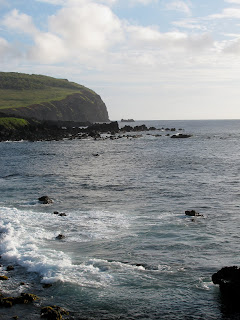After returning to Santiago from Puerto Varas, we went sightseeing around the city. Santiago is very different from Asuncion, in that its much, much larger, and a more modern city. It is also surrounded by the wonderful Andes MountainsSantiago has a wonderful metro system (which we used quite extensively), neighborhood parks and a great road system. The city also has tons of history, from being almost the southern tip of the Incan Empire, to being just south of the location of the Chilean battle for independence.
We started our exploration of the city by heading towards Cerro Santa Lucia (cerro means hill). The city has two different hills, Santa Lucia and San Cristobal, that are used to give directions.

We climbed up to Santa Lucia to see this statue of the Virgin Mary. The view of the city was absolutely amazing.

The next day we walked downtown to see the sites. Downtown Santiago reminded me a lot of European cities in the layout of the city. There were a couple of pedestrian only walkways, with sidewalk cafes and in the Plaza des Armas, there were lots of artists selling their paintings. After some time of discussion, I was able to convince Jesse to purchase one.

Then came New Year's Eve. Fellow teachers at our school, Shauna and Derek, were in Santiago as well, so we went to their hotel roof to watch the fireworks. Fireworks were going off in three different locations around the city, and we were able to see all of them at the same time. It was pretty sweet!
Our final day in Santiago, we went down to the presidential palace. We stumbled across a museum exhibit about the terracotta soldiers from China and decided to look in. It was packed with families and Chileans' enjoying the exhibit. It wasn't a museum on anything Chilean, but it was something we were interested in, and we enjoyed seeing the real soldiers.

Presidential Palace.

Terracotta soldiers on loan from a museum in China.

























